TikTok leads flow into Keap smoothly. However, matching each lead to its originating TikTok ad isn’t an option.
Even after a lead converts to a customer, you can’t associate that customer with any specific TikTok ad.
The inability to track leads from TikTok ads significantly limits your capacity to accurately assess their performance and effectiveness. As a result, you end up running several ads without knowing which bring in leads or customers.
Fortunately, a clear solution is in place to associate each lead with the precise TikTok campaign, ad group, and ad that generated it.
Let’s go through each step together!
How to capture TikTok ads in Keap
Step 1: Add Leadsources in the head tag of your website

Leadsources is a simple tool for tracking lead sources. When implemented on your website, it records up to 7 key pieces of information for every lead.
Sign up to Leadsources.io – it’s free.
Insert the Leadsources tracking code into the head tag of your website – follow this guide.
Step 2: Add the UTM parameters to your TikTok ads

In your URL, include UTM parameters for tracking TikTok ads: campaign, ad group, and ad.
You can add the following UTM parameters:
- UTM_medium=paidsocial
- UTM_source=tiktok
- UTM_campaign=campaign-name
- UTM_term=ad-group-name
- UTM_content=ad-name
Here’s how your final URL should look:
https://www.yoursite.com/?UTM_medium=paidsocial&UTM_source=tiktok&UTM_campaign=campaign-name&UTM_term=ad-group-name&UTM_content=ad-nameKeep in mind: Leadsources gathers all lead source information, including channel, landing page, and subfolder, without requiring UTM parameters, ensuring complete tracking for every lead.
Step 3: Add the hidden fields in your form

The lead source data collected by Leadsources is stored within the hidden fields of your form.
Upon submission of your form by a new lead, Leadsources inserts the TikTok ads information into the hidden fields.
To get detailed instructions on how to add hidden fields in your form, refer to this guide.
Step 4: Capture the TikTok ads data in Keap

When users interact with your ads and land on your site, Leadsources tracks the TikTok ads information: campaign, ad group, and ad.
Automatically, Leadsources populates the hidden fields in your form with TikTok ads information.
Upon submitting the form, you can directly transmit TikTok ads data and your leads to Keap by associating your form with Keap.
How does Leadsources work?
Leadsources logs the TikTok ads information each time a visitor comes to your website.
This TikTok ads information is captured in the hidden fields of your form. Upon submitting the form, the data is dispatched to Keap, along with the lead details (name, email, etc.).
Leadsources tracks these details for every visitor:
- Channel
- Source
- Campaign
- Content
- Term
- Landing page
- Landing page subfolder
Leadsources can track lead source data through the referrer, even when UTM parameters are missing.
It may not be possible to implement UTM parameters in cases where traffic comes from organic channels:
- Google Search
- Instagram bio link
- Social media posts
- Etc.
In these situations, many lead source tracking tools cannot determine lead sources due to their reliance on UTM parameters. On the other hand, Leadsources manages to collect specific lead source data, even when UTM parameters are not used:
- Channel
- Source
- Landing page
- Landing page subfolder
Thus, unlike several other lead tracking tools, Leadsources ensures comprehensive tracking of lead data across every channel:
- Organic Search
- Paid Search
- Organic Social
- Paid Social
- Referral
- Affiliate
- Display Advertising
- Direct Traffic
Additionally, Leadsources systematically categorizes your traffic by channel, leading to an organized dataset.
To sum up, Leadsources is a reliable and easy-to-use tool that captures detailed lead source data from all channels in a single location.
Performance reports: Lead, sales, and revenue by source
By capturing TikTok ads data in Keap, you can develop multiple performance reports, such as:
- Leads, sales, and revenue by channel
- Leads, sales, and revenue by source
- Leads, sales, and revenue by campaign (aka. Tiktok campaign)
- Leads, sales, and revenue by term (aka. Tiktok ad group)
- Leads, sales, and revenue by content (aka. TikTok ad)
- Leads, sales, and revenue by landing page
- Leads, sales, and revenue by landing page subfolder
Thus, you can adjust your TikTok budget in accordance with the campaign, ad group, and ad that yield your leads, sales, and revenue.
Now, let’s explore the different lead performance reports you can compile using this data.
1. Lead source reports
Develop performance reports that highlight the number of leads sourced from:
- Channel
- Source
- Campaign
- Term (aka. TikTok ad group)
- Content (aka. TikTok ad)
- Landing page
- Landing page subfolder
Example #1: Leads by channel
This report allows you to discover the channel that is the primary source of your leads.

Example #2: Leads by TikTok campaign
At this point, you can isolate a certain lead source (e.g., TikTok) and analyze the number of leads generated by every TikTok campaign.

Example #3: Leads by TikTok ad
After recognizing the TikTok campaign that drives the most leads, you can assess which specific ad group or ad is responsible for this success.

2. Sales and revenue source reports
Now that we know the TikTok campaign, ad group, and ad that yield our leads, we should explore whether these leads are effectively driving sales and revenue.
It’s important to identify which leads are successfully converted into customers. To do this, connect your leads to a CRM like Keap, which will enable you to monitor sales and revenue from various channels, sources, TikTok campaigns, ad groups, ads, landing pages, and more.
As a result, you can tailor your TikTok ads strategy to focus on the channels, sources, campaigns, ad groups, and ads that are effective in generating sales and revenue.
As a result, you can generate multiple sales and revenue reports like:
- Sales and revenue by source
- Sales and revenue by campaign
- Sales and revenue by term (aka. TikTok ad group)
- Sales and revenue by content (aka. TikTok ad)
- Sales and revenue by landing page
- Sales and revenue by landing page subfolder
To highlight this, let’s take a look at the following case:
| Channels | Search Paid | Social Paid |
| Leads | 50 | 75 |
| Sales | 5 | 6 |
| Average order value | $150 | $100 |
| Revenue | $750 | $600 |
Upon launching ads on Google and TikTok, the first “Leads by Channel” report demonstrated that Social Paid ads (TikTok) yielded more leads than Search Paid ads.
Still, after extracting your sales and revenue data from your CRM, you discovered that the Search Paid channel brought in more revenue with a lower number of leads compared to the Social Paid channel. Consequently, you made the decision to raise the budget for the Search Paid channel.
LeadSources tracks the source of each lead in Keap, whether they come from ads, organic search, social, email, etc. and syncs that data with each submission. See the full breakdown on the lead source in Keap page.

